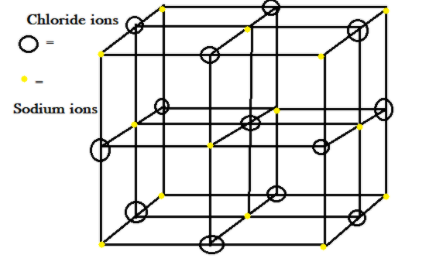
How would you describe the arrangement of sodium ions
Answer
466.2k+ views
Hint: Take help of types of unit cell, which are of three types simple cubic, body centred and face centred. These unit cells are a small portion of three dimensional lattice, when we rotate the unit cells all around it will give us a lattice. Here ions are arranged in such a way that crystals of sodium chloride
Complete step-by-step answer:
In the chapter on solid state, it gives us an idea of how the complex structures are arranged. A lattice is formed by the number of atoms arranged in a small unit cell. Unit cells have sides which may be equal or not. Famously we talk a lot about the cubic cell type. These cells are such that the position of atoms or ions matters. We have three types of cubic unit cells. The first one is the simple cubic in this type. The particles are just at the corner and you can imagine that while sitting in your room. So as there are eight corners in a cube so there are eight atoms in a simple cubic unit cell.
In the other two that are body centred and face centred, the atoms are arranged including eight corners and also at the body centred which is just between the cube and in face centred atoms are also present at each of the face including the corners.
The lattice crystal given of sodium chloride
We have a lattice which is formed by chloride ions

Note: To understand any crystal lattice, consider a small part i.e. unit cell where the atoms are arranged. In the above example of
Complete step-by-step answer:
In the chapter on solid state, it gives us an idea of how the complex structures are arranged. A lattice is formed by the number of atoms arranged in a small unit cell. Unit cells have sides which may be equal or not. Famously we talk a lot about the cubic cell type. These cells are such that the position of atoms or ions matters. We have three types of cubic unit cells. The first one is the simple cubic in this type. The particles are just at the corner and you can imagine that while sitting in your room. So as there are eight corners in a cube so there are eight atoms in a simple cubic unit cell.
In the other two that are body centred and face centred, the atoms are arranged including eight corners and also at the body centred which is just between the cube and in face centred atoms are also present at each of the face including the corners.
The lattice crystal given of sodium chloride
We have a lattice which is formed by chloride ions

Note: To understand any crystal lattice, consider a small part i.e. unit cell where the atoms are arranged. In the above example of
Recently Updated Pages
Master Class 9 General Knowledge: Engaging Questions & Answers for Success

Master Class 9 English: Engaging Questions & Answers for Success

Master Class 9 Science: Engaging Questions & Answers for Success

Master Class 9 Social Science: Engaging Questions & Answers for Success

Master Class 9 Maths: Engaging Questions & Answers for Success

Class 9 Question and Answer - Your Ultimate Solutions Guide

Trending doubts
State and prove Bernoullis theorem class 11 physics CBSE

What are Quantum numbers Explain the quantum number class 11 chemistry CBSE

Who built the Grand Trunk Road AChandragupta Maurya class 11 social science CBSE

1 ton equals to A 100 kg B 1000 kg C 10 kg D 10000 class 11 physics CBSE

State the laws of reflection of light

One Metric ton is equal to kg A 10000 B 1000 C 100 class 11 physics CBSE




